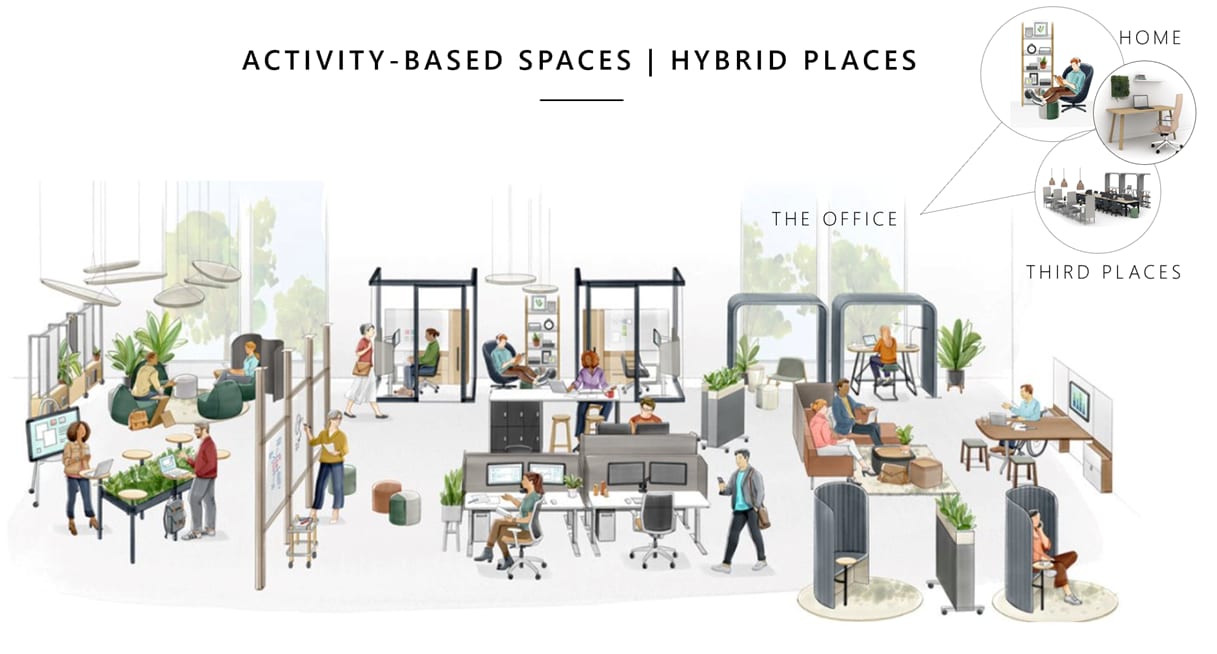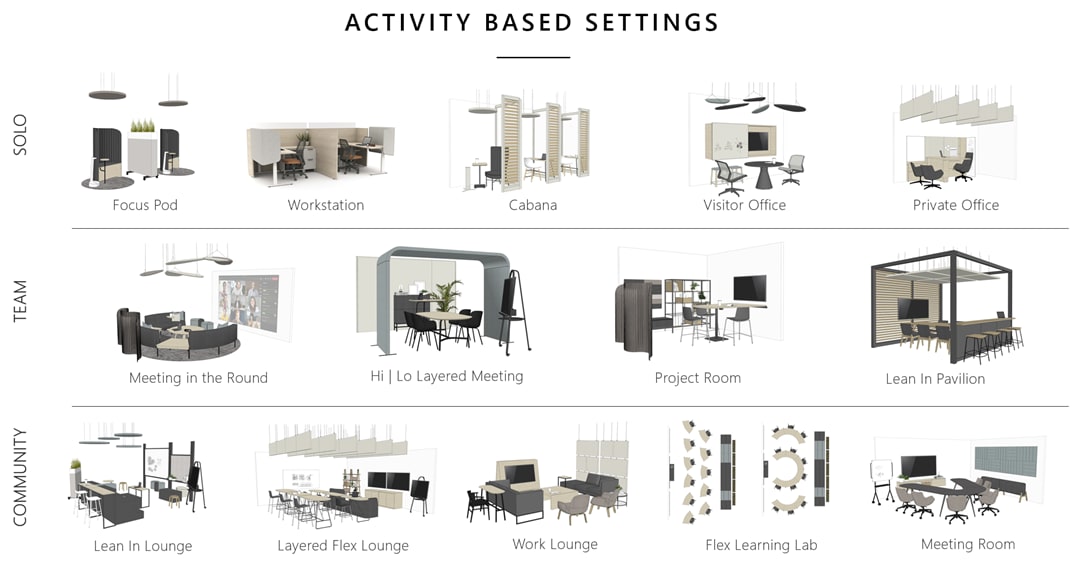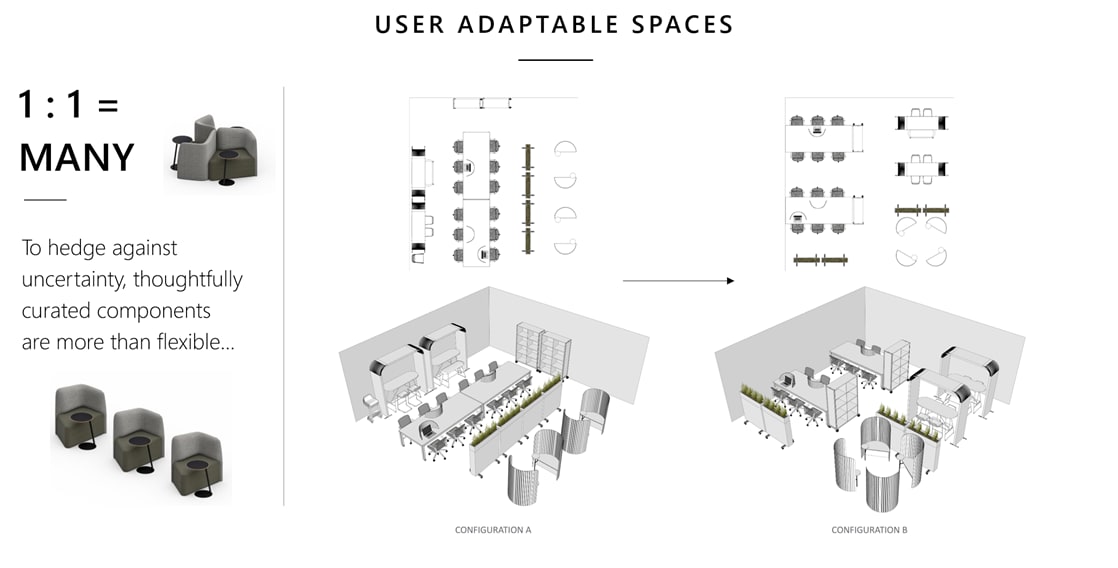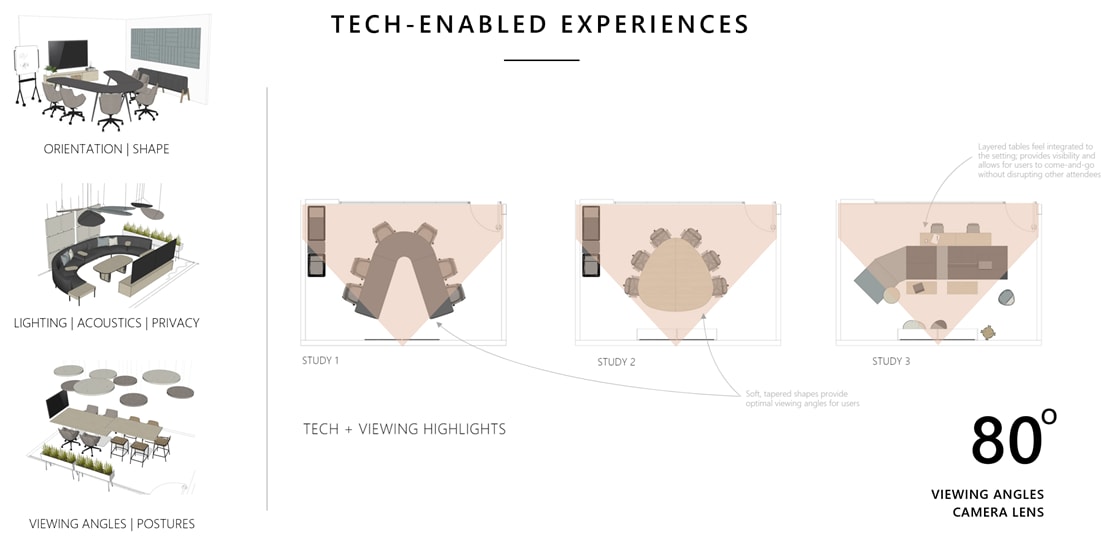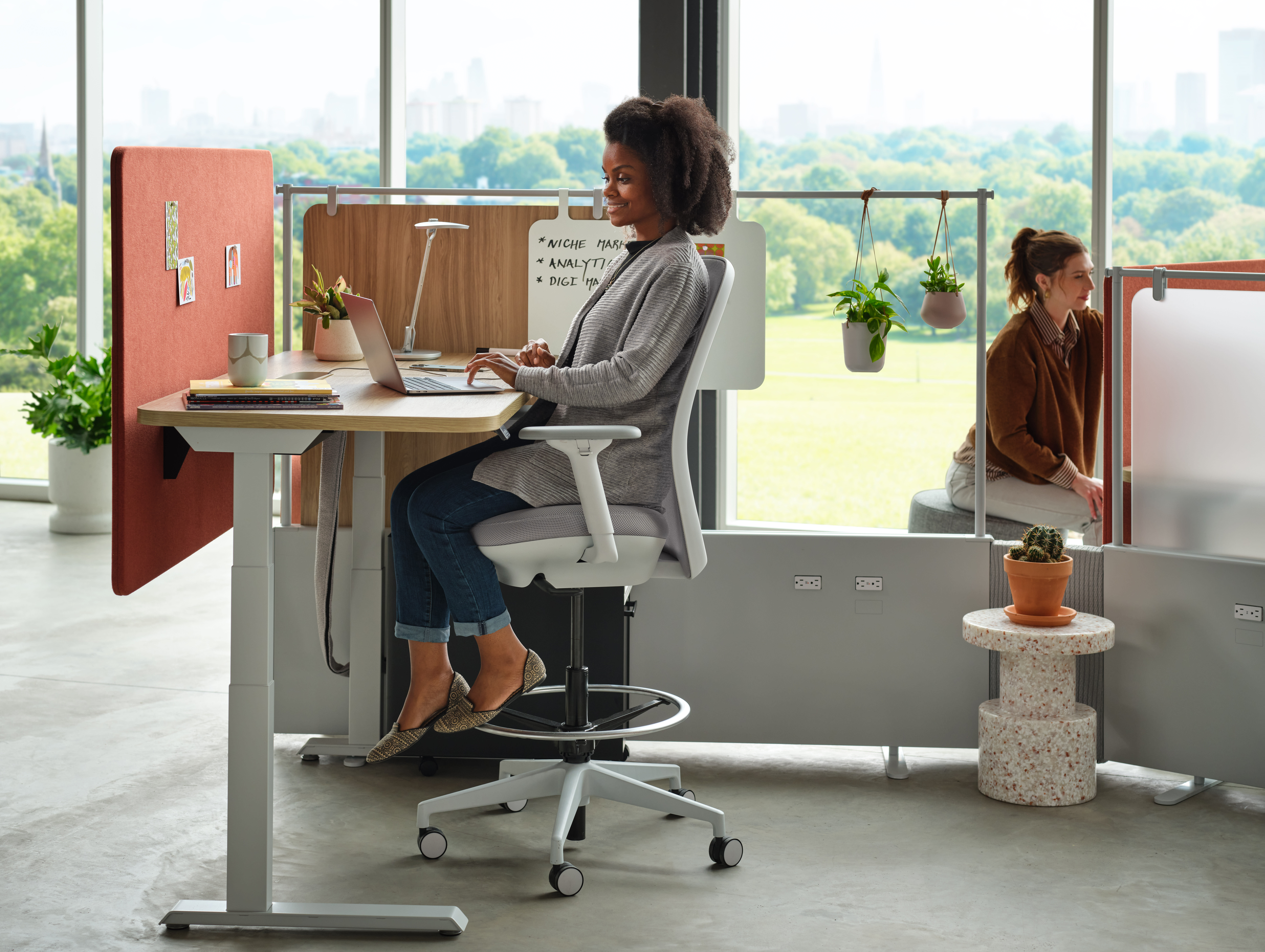Now, more than ever, so many of us have an expanded range of choice in how, where, and when we do our best work. And this expands far beyond the physical boundaries of the ‘traditional’ office.
If we are to find a positive from the pandemic, it has taught us that work truly can and does happen anywhere and everywhere. And while we understand and appreciate the value and importance of coming together for reasons such as a sense of belonging and social cohesion, there are times when the ‘office’ simply may NOT be the best choice. I like to think about this ‘choice’ as similar to the movement of business casual in the late 1980s. If you had a client meeting, you wore something different than if you were in internal meetings all day- you would ‘dress for your day.’ Similarly, think of ‘work for your day,’ as in you choose where, when, and how you will best support your activities and engagements.
As organizations offer more choice, we as designers are presented with the unique opportunity to create a more robust range of settings that will elevate the experience – no matter where teams are located. And more importantly, on a ‘human level,’ this expanded choice helps to balance day-to-day work and life.
We would be remiss not to mention the impacts to the employer of offering choice are significant, not only from a real estate portfolio perspective, but furniture, technology, protocols, and management styles. To touch on technology (equipment) for a moment, think about how many of us may have brought our dual monitors home early in the Pandemic. Now, as we go into the office and are only working from our laptop, are we as effective? These ‘preferred’ behaviors will impact organizations' furniture and technology (software and hardware) standards, not to mention employees' decisions in how and where they choose to work.
Activity Based Planning
Activity based planning is not a new idea, but it feels new because of our current reality and heightened awareness of the importance of place. Now - more than ever, we are paying more attention to the human experience in the workplace. Linking the actual activity being performed to the physical manifestation of how optimal results are achieved is key on our minds.
We have been talking about Activity Based Planning as a means for supporting choice in the workplace for a long time; planning a variety of spaces based on the activities performed. These choices extend outside the traditional idea of ‘workplace’ to many areas including home office, main office and other ‘third place’ locations in between. Even the movement of outdoor expansion has evolved our idea of how and where work is best performed.
Offering employees thoughtful, curated work environments that address solo, team and community work practices will enhance not only individual worker performance and focus, but also the highly valuable collaborative engagements, elevating one of the most missed experiences of our recent, ‘physically siloed’ reality.
User Adaptable Spaces
Let us start with why we say ‘adaptable’ verses ‘flexible.’ A rubber band is flexible; it stretches and returns to its original shape. What we mean by ‘adaptive’ is the intention or application of the object(s) can morph and adjust to accommodate a different function or purpose. This is a core principle we consider in our product development process.
Organizations, and those of us who help design and procure spaces need to be thinking about how the physical environment can accommodate strategic shifts. As place makers, we need to consider, and anticipate, the evolving workplace as a dynamic eco-system of places and spaces that can keep morphing over time to keep up with changing norms and business changes in the organization. We care about adaptability because our clients’ care. Our ability to help hedge against the inevitable uncertainty our clients face is part of our DNA. As we work with clients and translate their current state requirements, we also show them ‘what could be’ scenarios.
This means space adapts WITH the changing nature of work, in a simpler, more organized, and less painful process. This is well received by clients, facility managers and the teams as they navigate productive and meaningful work during times of change.
Tech Enabled Spaces
Overnight, technology-enabled strategies became the lynchpin to continued operations for business across almost every industry. Organizational leaders that once believed that remote, or hybrid work strategies could not deliver the same productivity as traditional in-office work found themselves, and their workers, in an environment where working across distance, with geographically dispersed employees became mandatory.
A technology-enabled space does not require a sophisticated definition, but for the purposes of level-setting the discussion, we are talking about a space that includes various technologies implemented to improve user productivity within that space. It is important to keep in mind that when we say, "user," or "users," that we are not only speaking about the individuals physically occupying that space, but also anyone engaging remotely with those individuals. This could be in the form of one direction communication, like a presentation, or multi-directional engagements where the on-premises users interact and collaborate with the remote users.
Physical considerations when updating your existing meeting spaces - or designing new, have become more complex due to the expanded requirements and expectations of enhance distributed collaboration. The shape, size, and orientation of the room; the acoustical performance, lighting, and level of enclosure to minimize distractions are just a few of the many factors to be addressed in concert with the actual technology. As furniture providers, coordination with our AV consultants and partners is critical to a successful environment and user experience, in person and remotely.
As we know, technology has been an integral part of work and life for decades. The onset of the pandemic has only accelerated its evolution, how deeply it is integrated into the ways we work, and changed the expectations workers have for the modern workplace. Companies are having to rapidly rethink their strategies in staffing their organizations, the ways that teams are built or organized, and the levers they can pull to ensure equity for users—co-located, or remote—and drive the best outcomes in terms of productivity, wellness, and attraction and retention of talent.
It is imperative that companies leverage technology as a tool to create spaces that support all employees, regardless of location. This is particularly exciting when we start to think about the geographic barriers to obtaining the best talent. Where organizations once had to rely on the best local talent available—or the best willing to relocate— now they can easily recruit around the globe.
The Importance of PlaceCurating settings that enhance individual performance and collaborative engagements is one way to amplify the human experience. Another way requires evaluating how/where/when employees do their best work and accommodating an expanded range of choice. |
Navigating Meaningful ChangeWe help our clients envision all the ‘What Could Be’ scenarios where space adapts with the changing nature of work – in a much simpler, more organized, and less challenging way. |
Allowing for Continuous WorkflowWe refer to easily accessible, dedicated team spaces adjacent to solo spaces as workplace neighborhoods. Much like neighborhoods in your own community, these defined areas within the floor plate exemplify unique characteristics that set teams apart. |
The Workplace EcosystemWhen we mention the ecosystem, we’re referring to all the interactions and places where work happens today – whether that’s the office, a library, park, or coffee shop. An organization’s culture and its people define what that ecosystem is. |
Digital Equity in the WorkplaceTechnology is constantly evolving how we interact, work, live, and play. Now more than ever, organizations should embrace tech-enabled spaces and carefully consider ways to close any digital equity gaps for hybrid/remote workers. |
Choice Resources
Our virtual learning series is all about staying connected and having compelling conversations about the hottest topics in our industry today. Each month we have a panel of experts, from diverse disciplines, discuss a myriad of topics that center around the workplace. Join us!




